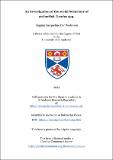Files in this item
An investigation of the social behaviour of archerfish Toxotes spp.
Item metadata
| dc.contributor.advisor | Rendell, Luke | |
| dc.contributor.advisor | Webster, Mike (Mike M.) | |
| dc.contributor.advisor | Sillar, Keith T. (Keith Thomas) | |
| dc.contributor.author | Der Weduwen, Dagmar Jacqueline | |
| dc.coverage.spatial | 161 | en_US |
| dc.date.accessioned | 2024-03-06T09:18:30Z | |
| dc.date.available | 2024-03-06T09:18:30Z | |
| dc.date.issued | 2024-06-12 | |
| dc.identifier.uri | https://hdl.handle.net/10023/29437 | |
| dc.description.abstract | Sociality has evolved multiple times in animals. Social living is a balance between the advantages and disadvantages of the increased presence of conspecifics. These costs and benefits are especially prevalent when foraging, as both the chance to discover resources and the rate at which they are depleted increase with group size. This holds true for archerfish Toxotes spp., a genus known for shooting down terrestrial prey using concentrated jets of water. This hunting method leaves the shooters open to theft, but whether and how their foraging behaviour and decision-making are affected by this threat is unclear. I investigated how group size affected aiming duration and shooting success, performed a pilot investigation into the use of video demonstrators for standardising social stimuli in such experiments, and tested whether archerfish socially learn target preferences when foraging in a group. I found evidence that archerfish decrease their aiming duration in the presence of more conspecifics. My results contradict previous research on kleptoparasitism in archerfish, mainly that the rate of kleptoparasitism is dependent on the behaviour of the shooter’s neighbours rather than group size. I also showed that archerfish avoid videos of conspecifics, although the explanation for this remains elusive. I attempted to find out whether archerfish can learn socially but instead found no evidence of learning. As scientists, we must study the natural world and share our findings with the public who fund our work. Accordingly, I created a tabletop role-playing style game based on archerfish ecology to test whether it could educate the public about my research and found that most participants improved their knowledge of archerfish. This thesis not only helps to further elucidate the social behaviour of archerfish but also illustrates how an animal’s ecology must be taken into consideration when conducting research and conveying the results to the public. | en_US |
| dc.description.sponsorship | "This work was supported by a BBSRC Eastbio PhD studentship awarded to Dagmar der Weduwen."--Funding | en |
| dc.language.iso | en | en_US |
| dc.rights | Creative Commons Attribution-NonCommercial 4.0 International | * |
| dc.rights.uri | http://creativecommons.org/licenses/by-nc/4.0/ | * |
| dc.subject | Social learning | en_US |
| dc.subject | Social behaviour | en_US |
| dc.subject | Archerfish | en_US |
| dc.subject | Public engagement | en_US |
| dc.subject | Animal behaviour | en_US |
| dc.subject.lcc | QL638.T6D4 | |
| dc.subject.lcsh | Archer fishes--Behavior | en |
| dc.subject.lcsh | Fishes--Behavior | en |
| dc.subject.lcsh | Social behavior in animals | en |
| dc.title | An investigation of the social behaviour of archerfish Toxotes spp. | en_US |
| dc.type | Thesis | en_US |
| dc.contributor.sponsor | Biotechnology and Biological Sciences Research Council (BBSRC) | en_US |
| dc.type.qualificationlevel | Doctoral | en_US |
| dc.type.qualificationname | PhD Doctor of Philosophy | en_US |
| dc.publisher.institution | The University of St Andrews | en_US |
| dc.identifier.doi | https://doi.org/10.17630/sta/808 |
The following licence files are associated with this item:
This item appears in the following Collection(s)
Except where otherwise noted within the work, this item's licence for re-use is described as Creative Commons Attribution-NonCommercial 4.0 International
Items in the St Andrews Research Repository are protected by copyright, with all rights reserved, unless otherwise indicated.


